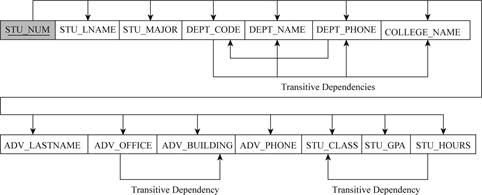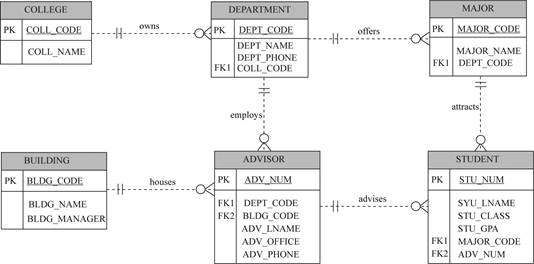
Concept explainers
a.
Normalization:
The process used to minimize data redundancy and dependency in a relational
Second normal form (2NF):
- The value of all non-primary key attributes should be dependent on the primary key attribute.
- If any attribute is depending on the partial primary key then it should determine the other attributes for an instance of the entity.
- The partial dependencies should be removed from the data model.
Third normal form (3NF):
- The value of any non-primary key attributes will not depend on any other non-primary key attributes.
- If any non-primary key attributes depend on any other non-primary key attribute then it should be moved or deleted.
- It is termed as transitive dependency.
Partial dependency:
A partial dependency exists at that time of an attributes depends only a part of primary key. This dependency is related with 1st normal form.
Transitive dependency:
A transitive dependency exists at that time of an attributes depends on another attribute which is not part of primary key.
Functional dependency:
An association between two attributes or two set of attributes in a same relational database table, which is having some constraints is known as functional dependency.
- In a table one attribute is functionally dependent on another attribute to take one value.
a.
Explanation of Solution
Construct the dependency diagram with all partial and transitive dependencies:
The relational schema for given STUDENT table is given below:
STUDENT(STU_NUM, STU_LNAME, STU_MAJOR, DEPT_CODE, DEPT_NAME,
DEPT_PHONE, ADVISOR_LNAME, ADVISOR_OFFICE, ADVISOR_BLDG, ADVISOR_PHONE, STU_GPA, STU_HOURS, STU_CLASS)
- Here, “STU_NUM” indicates the primary key.
The representation of dependency diagram with all transitive dependencies is shown below:

Explanation:
In the above dependency diagram,
- The transitive dependency is,
DEPT_CODE -> (DEPT_NAME, DEPT_PHONE, COLLEGE_NAME)
ADV_OFFICE -> (ADV_BUILDINGS)
STU_HOURS -> (STU_CLASS)
b.
Normalization:
The process used to minimize data redundancy and dependency in a relational database is known as normalization. The database table is divided into two or more tables and defines the relationship between those tables.
Second normal form (2NF):
- The value of all non-primary key attributes should be dependent on the primary key attribute.
- If any attribute is depending on the partial primary key then it should determine the other attributes for an instance of the entity.
- The partial dependencies should be removed from the data model.
Third normal form (3NF):
- The value of any non-primary key attributes will not depend on any other non-primary key attributes.
- If any non-primary key attributes depend on any other non-primary key attribute then it should be moved or deleted.
- It is termed as transitive dependency.
Partial dependency:
A partial dependency exists at that time of an attributes depends only a part of primary key. This dependency is related with 1st normal form.
Transitive dependency:
A transitive dependency exists at that time of an attributes depends on another attribute which is not part of primary key.
Functional dependency:
An association between two attributes or two set of attributes in a same relational database table, which is having some constraints is known as functional dependency.
- In a table one attribute is functionally dependent on another attribute to take one value.
b.
Explanation of Solution
Construct the dependency diagram:
The new dependency diagram is represented by removing all transitive dependencies in STUDENT table.
First table:
The relational schema for first table is given below:
STUDENT(STU_NUM, STU_LNAME, STU_MAJOR, DEPT_CODE, ADVISOR_NUM STU_GPA, STU_HOURS, STU_CLASS)
- Here, “STU_NUM” indicates the primary keys and “ADVISOR_NUM” indicates the foreign key.
- The relation is in third normal form (2NF), since there is transitive dependency in this table.
The representation of dependency diagram in first table is shown below:

Second table:
The relational schema for second table is given below:
MAJOR(MAJOR_CODE, DEPT_CODE, MAJOR_DESCRIPTION)
- Here, “MAJOR_CODE” indicates the primary key.
- The relation is in third normal form (3NF), since there is no transitive dependency and no repeated attributes.
The representation of dependency diagram in second table is shown below:

Third table:
The relational schema for third table is given below:
BUILDING(BLDG_CODE, BLDG_NAME, BLDG_MANAGER)
- Here, “BLDG_CODE” indicates the primary key.
- The relation is in third normal form (3NF), since there is no transitive dependency and no repeated attributes.
The representation of dependency diagram in third table is shown below:

Fourth table:
The relational schema for fourth table is given below:
DEPARTMENT(DEPT_NAME, DEPT_PHONE, COLL_CODE)
- Here, “DEPT_NAME” indicates the primary key.
- The relation is in third normal form (3NF) but it does not meet the BCNF, since there is no transitive dependency and no repeated attributes.
The representation of dependency diagram in fourth table is shown below:

Fifth table:
The relational schema for fifth table is given below:
COLLEGE(COLL_CODE, COLL_NAME)
- Here, “COLL_CODE” indicates the primary key.
- The relation is in third normal form (3NF), since there is no transitive dependency and no repeated attributes.
The representation of dependency diagram in fifth table is shown below:

Sixth table:
The relational schema for sixth table is given below:
ADVISOR(ADV_NUM, ADV_LASTNAME, ADV_OFFICE, ADV_BUILDING, ADV_PHONE)
- Here, “ADV_NUM” indicates the primary key.
- The dotted transitive dependency line specifies that dependency is interpretation.
- The relation is in third normal form (2NF), since there is transitive dependency in this table.
The representation of dependency diagram in sixth table is shown below:

c.
Explanation of Solution
The representation of Crow’s Foot Entity Relational Diagram (ERD) is shown below:
The following data model shows the solution for the given question.

Explanation:
- In the above data model, the college owns more than one department.
- The “COLLEGE” entity contains the “COLL_CODE” and “COLL_NAME” attributes.
- The primary key of “COLL_CODE” entity is “INV_NUM”.
- The “DEPARTMENT” entity contains the “DEPT_CODE”, “DEPT_NAME”, “DEPT_PHONE” and “COLL_CODE” attributes.
- The primary of this entity is “DEPT_CODE”.
- The foreign key of this entity is “COLL_CODE”.
- The “COLLEGE” entity contains the “COLL_CODE” and “COLL_NAME” attributes.
- The department offers more than one major.
- The “MAJOR” entity contains the “MAJOR_CODE”, “MAJOR_NAME”, and “DEPT_CODE” attributes.
- The primary key of “MAJOR_CODE” for this entity.
- The foreign key of this entity is “VEND_CODE”.
- The “MAJOR” entity contains the “MAJOR_CODE”, “MAJOR_NAME”, and “DEPT_CODE” attributes.
- The major attracts more than one student.
- The “STUDENT” entity contains the “STU_NUM”, “STU_LNAME”, “STU_CLASS”, “STU_HOURS”, “STU_GPA”, “MAJOR_CODE”, and “ADV_NUM” attributes.
- The primary key of “STU_NUM” entity.
- The foreign key of this entity is “MAJOR_CODE” and “ADV_NUM”.
- The “STUDENT” entity contains the “STU_NUM”, “STU_LNAME”, “STU_CLASS”, “STU_HOURS”, “STU_GPA”, “MAJOR_CODE”, and “ADV_NUM” attributes.
- The building houses more than one advisor.
- The “ADVISOR” entity contains the “ADV_NUM”, “DEPT_CODE”, “BLDG_CODE”, “ADV_LNAME”, “ADV_OFFICE”, and “ADV_PHONE” attributes.
- The primary key of “ADV_NUM” entity.
- The foreign key of this entity is “DEPT_CODE” and “BLDG_CODE”.
- The “BUILDING” entity contains the “BLDG_CODE”, “BLDG_NAME” and “BLDG_MANAGER” attributes.
- The primary key of “BLDG_CODE” entity.
- The “ADVISOR” entity contains the “ADV_NUM”, “DEPT_CODE”, “BLDG_CODE”, “ADV_LNAME”, “ADV_OFFICE”, and “ADV_PHONE” attributes.
- The advisor advises more than one student.
Want to see more full solutions like this?
Chapter 6 Solutions
Database Systems: Design, Implementation, Management, Loose-leaf Version
- using r language for integration theta = integral 0 to infinity (x^4)*e^(-x^2)/2 dx (1) use the density function of standard normal distribution N(0,1) f(x) = 1/sqrt(2pi) * e^(-x^2)/2 -infinity <x<infinity as importance function and obtain an estimate theta 1 for theta set m=100 for the estimate whatt is the estimate theta 1? (2)use the density function of gamma (r=5 λ=1/2)distribution f(x)=λ^r/Γ(r) x^(r-1)e^(-λx) x>=0 as importance function and obtain an estimate theta 2 for theta set m=1000 fir the estimate what is the estimate theta2? (3) use simulation (repeat 1000 times) to estimate the variance of the estimates theta1 and theta 2 which one has smaller variance?arrow_forwardusing r language A continuous random variable X has density function f(x)=1/56(3x^2+4x^3+5x^4).0<=x<=2 (1) secify the density g of the random variable Y you find for the acceptance rejection method. (2) what is the value of c you choose to use for the acceptance rejection method (3) use the acceptance rejection method to generate a random sample of size 1000 from the distribution of X .graph the density histogram of the sample and compare it with the density function f(x)arrow_forwardusing r language a continuous random variable X has density function f(x)=1/4x^3e^-(pi/2)^4,x>=0 derive the probability inverse transformation F^(-1)x where F(x) is the cdf of the random variable Xarrow_forward
- using r language in an accelerated failure test, components are operated under extreme conditions so that a substantial number will fail in a rather short time. in such a test involving two types of microships 600 chips manufactured by an existing process were tested and 125 of them failed then 800 chips manufactured by a new process were tested and 130 of them failed what is the 90%confidence interval for the difference between the proportions of failure for chips manufactured by two processes? using r languagearrow_forwardI want a picture of the tools and the pictures used Cisco Packet Tracer Smart Home Automation:o Connect a temperature sensor and a fan to a home gateway.o Configure the home gateway so that the fan is activated when the temperature exceedsa set threshold (e.g., 30°C).2. WiFi Network Configuration:o Set up a wireless LAN with a unique SSID.o Enable WPA2 encryption to secure the WiFi network.o Implement MAC address filtering to allow only specific clients to connect.3. WLC Configuration:o Deploy at least two wireless access points connected to a Wireless LAN Controller(WLC).o Configure the WLC to manage the APs, broadcast the configured SSID, and applyconsistent security settings across all APs.arrow_forwardA. What will be printed executing the code above?B. What is the simplest way to set a variable of the class Full_Date to January 26 2020?C. Are there any empty constructors in this class Full_Date?a. If there is(are) in which code line(s)?b. If there is not, how would an empty constructor be? (create the code lines for it)D. Can the command std::cout << d1.m << std::endl; be included after line 28 withoutcausing an error?a. If it can, what will be printed?b. If it cannot, how could this command be fixed?arrow_forward
- Cisco Packet Tracer Smart Home Automation:o Connect a temperature sensor and a fan to a home gateway.o Configure the home gateway so that the fan is activated when the temperature exceedsa set threshold (e.g., 30°C).2. WiFi Network Configuration:o Set up a wireless LAN with a unique SSID.o Enable WPA2 encryption to secure the WiFi network.o Implement MAC address filtering to allow only specific clients to connect.3. WLC Configuration:o Deploy at least two wireless access points connected to a Wireless LAN Controller(WLC).o Configure the WLC to manage the APs, broadcast the configured SSID, and applyconsistent security settings across all APs.arrow_forwardTransform the TM below that accepts words over the alphabet Σ= {a, b} with an even number of a's and b's in order that the output tape head is positioned over the first letter of the input, if the word is accepted, and all letters a should be replaced by the letter x. For example, for the input aabbaa the tape and head at the end should be: [x]xbbxx z/z,R b/b,R F ① a/a,R b/b,R a/a, R a/a,R b/b.R K a/a,R L b/b,Rarrow_forwardGiven the C++ code below, create a TM that performs the same operation, i.e., given an input over the alphabet Σ= {a, b} it prints the number of letters b in binary. 1 #include 2 #include 3 4- int main() { std::cout > str; for (char c : str) { if (c == 'b') count++; 5 std::string str; 6 int count = 0; 7 char buffer [1000]; 8 9 10 11- 12 13 14 } 15 16- 17 18 19 } 20 21 22} std::string binary while (count > 0) { binary = std::to_string(count % 2) + binary; count /= 2; std::cout << binary << std::endl; return 0;arrow_forward
- Considering the CFG described below, answer the following questions. Σ = {a, b} • NT = {S} Productions: P1 S⇒aSa P2 P3 SbSb S⇒ a P4 S⇒ b A. List one sequence of productions that can accept the word abaaaba; B. Give three 5-letter words that can be accepted by this CFG; C. Create a Pushdown automaton capable of accepting the language accepted by this CFG.arrow_forwardGiven the FSA below, answer the following questions. b 1 3 a a b b с 2 A. Write a RegEx that is equivalent to this FSA as it is; B. Write a RegEx that is equivalent to this FSA removing the states and edges corresponding to the letter c. Note: To both items feel free to use any method you want, including analyzing which words are accepted by the FSA, to generate your RegEx.arrow_forward3) Finite State Automata Given the FSA below, answer the following questions. a b a b 0 1 2 b b 3 A. Give three 4-letter words that can be accepted by this FSA; B. Give three 4-letter words that cannot be accepted by this FSA; C. How could you describe the words accepted by this FSA? D. Is this FSA deterministic or non-deterministic?arrow_forward
 Database Systems: Design, Implementation, & Manag...Computer ScienceISBN:9781305627482Author:Carlos Coronel, Steven MorrisPublisher:Cengage Learning
Database Systems: Design, Implementation, & Manag...Computer ScienceISBN:9781305627482Author:Carlos Coronel, Steven MorrisPublisher:Cengage Learning A Guide to SQLComputer ScienceISBN:9781111527273Author:Philip J. PrattPublisher:Course Technology Ptr
A Guide to SQLComputer ScienceISBN:9781111527273Author:Philip J. PrattPublisher:Course Technology Ptr Database Systems: Design, Implementation, & Manag...Computer ScienceISBN:9781285196145Author:Steven, Steven Morris, Carlos Coronel, Carlos, Coronel, Carlos; Morris, Carlos Coronel and Steven Morris, Carlos Coronel; Steven Morris, Steven Morris; Carlos CoronelPublisher:Cengage Learning
Database Systems: Design, Implementation, & Manag...Computer ScienceISBN:9781285196145Author:Steven, Steven Morris, Carlos Coronel, Carlos, Coronel, Carlos; Morris, Carlos Coronel and Steven Morris, Carlos Coronel; Steven Morris, Steven Morris; Carlos CoronelPublisher:Cengage Learning
 Principles of Information Systems (MindTap Course...Computer ScienceISBN:9781285867168Author:Ralph Stair, George ReynoldsPublisher:Cengage Learning
Principles of Information Systems (MindTap Course...Computer ScienceISBN:9781285867168Author:Ralph Stair, George ReynoldsPublisher:Cengage Learning Fundamentals of Information SystemsComputer ScienceISBN:9781337097536Author:Ralph Stair, George ReynoldsPublisher:Cengage Learning
Fundamentals of Information SystemsComputer ScienceISBN:9781337097536Author:Ralph Stair, George ReynoldsPublisher:Cengage Learning





